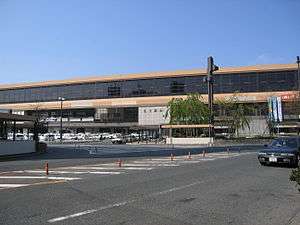Morioka Station
Morioka Station (盛岡駅, Morioka-eki) is a railway station in the city Morioka, Iwate Prefecture, Japan operated by JR East.
Morioka Station 盛岡駅 | ||||||||||||||||||||||||||||||||||||||||||||||||||||||||||||||||
|---|---|---|---|---|---|---|---|---|---|---|---|---|---|---|---|---|---|---|---|---|---|---|---|---|---|---|---|---|---|---|---|---|---|---|---|---|---|---|---|---|---|---|---|---|---|---|---|---|---|---|---|---|---|---|---|---|---|---|---|---|---|---|---|---|
 Morioka Station east entrance in May 2006 | ||||||||||||||||||||||||||||||||||||||||||||||||||||||||||||||||
| Location | 1-48 Moriokaekimae-dori, Morioka-shi, Iwate-ken Japan | |||||||||||||||||||||||||||||||||||||||||||||||||||||||||||||||
| Coordinates | 39.701442°N 141.136379°E | |||||||||||||||||||||||||||||||||||||||||||||||||||||||||||||||
| Operated by |
| |||||||||||||||||||||||||||||||||||||||||||||||||||||||||||||||
| Line(s) |
| |||||||||||||||||||||||||||||||||||||||||||||||||||||||||||||||
| Distance | 535.3 km from Tokyo | |||||||||||||||||||||||||||||||||||||||||||||||||||||||||||||||
| Platforms | 7 island platforms | |||||||||||||||||||||||||||||||||||||||||||||||||||||||||||||||
| Connections | Bus terminal | |||||||||||||||||||||||||||||||||||||||||||||||||||||||||||||||
| Construction | ||||||||||||||||||||||||||||||||||||||||||||||||||||||||||||||||
| Structure type | Elevated | |||||||||||||||||||||||||||||||||||||||||||||||||||||||||||||||
| Other information | ||||||||||||||||||||||||||||||||||||||||||||||||||||||||||||||||
| Status | Staffed (Midori no Madoguchi) | |||||||||||||||||||||||||||||||||||||||||||||||||||||||||||||||
| History | ||||||||||||||||||||||||||||||||||||||||||||||||||||||||||||||||
| Opened | November 1, 1890 | |||||||||||||||||||||||||||||||||||||||||||||||||||||||||||||||
| Traffic | ||||||||||||||||||||||||||||||||||||||||||||||||||||||||||||||||
| Passengers (FY2015) |
| |||||||||||||||||||||||||||||||||||||||||||||||||||||||||||||||
| Services | ||||||||||||||||||||||||||||||||||||||||||||||||||||||||||||||||
| ||||||||||||||||||||||||||||||||||||||||||||||||||||||||||||||||
| Location | ||||||||||||||||||||||||||||||||||||||||||||||||||||||||||||||||
 Morioka Station Location within Japan | ||||||||||||||||||||||||||||||||||||||||||||||||||||||||||||||||
Lines
Morioka Station is a major junction station, and is served by both the Tōhoku Shinkansen and the Akita Shinkansen. It is located 535.3 km from Tokyo Station. Local JR East services are provided by the Tohoku Main Line, Tazawako Line and Yamada Line, all of which terminate at Morioka Station. The station is also the southern terminus of the third-sector Iwate Ginga Railway Line.
Station layout
The station has three elevated island platforms for Shinkansen services, and four island platforms for local services. The station has a Midori no Madoguchi staffed ticket office.
Platforms
| 0/1 | ■ Iwate Ginga Railway Line | for Iwate-Numakunai and Ninohe |
| ■ Hanawa Line | for Araya-Shinmachi and Kazuno-Hanawa | |
| 2 | ■ Tōhoku Main Line | for Hanamaki, Kitakami and Ichinoseki |
| ■ Yamada Line | for Moichi and Miyako | |
| ■ Iwate Ginga Railway Line | for Iwate-Numakunai (JR Line through operation | |
| 3 | ■ Tōhoku Main Line | for Hanamaki, Kitakami and Ichinoseki |
| ■ Iwate Ginga Railway Line | for Iwate-Numakunai (JR Line through operation | |
| 4/5 | ■ Tōhoku Main Line | for Hanamaki, Kitakami and Ichinoseki |
| 6 | ■ Tōhoku Main Line | for Hanamaki, Kitakami and Ichinoseki |
| ■ Yamada Line | for Moichi and Miyako | |
| 7 | ■ Tōhoku Main Line | for Hanamaki, Kitakami and Ichinoseki |
| 8/9 | ■ Tazawako Line | for Shizukuishi and Ōmagari |
| 11 | ■ Tohoku Shinkansen | for Sendai and Tokyo |
| 12/13 | ■ Tohoku Shinkansen | for Sendai and Tokyo (Departure) |
| 14 | ■ Tohoku Shinkansen | for Ninohe, Hachinohe, Shin-Aomori and Shin-Hakodate-Hokuto |
| ■ Akita Shinkansen | for Ōmagari and Akita |
History
The station was opened on November 1, 1890, by Japan's first private railway company, Nippon Railway. The line was nationalized in 1906. Services on the Tazawako Line started in 1921, on the Yamada line in 1923, the Tohoku Shinkansen in 1982 and the Akita Shinkansen in 1997. The station was absorbed into the JR East network upon the privatization of the Japanese National Railways (JNR) on 1 April 1987.
Passenger statistics
In fiscal 2015, the JR East portion of the station was used by an average of 17,784 passengers daily (boarding passengers only).[1] The Iwate Ginga Railway portion of the station was used by an average of 3,257 passengers daily.[2]
Surrounding area
East exit
- Morioka Station building "Fezan"
- Moriokaekimae Post office
- JR East Morioka branch office
- JR bus Tōhoku Morioka branch office
West exit
- Iwate Asahi Television Co., Ltd.
Connecting bus routes
Local
- JR Bus Tōhoku
- For Kuji Station via Iwate-Numakunai Station and Kuzumaki
- For Iwaizumi via Hayasaka-Kōgen
- Iwate-Kenhoku Bus
- For Miyako Station ("Route 106 Express Bus")
- For Iwate-Funakoshi Station via Miyako Station ("Route 106 Express Bus")
- For Numakunai via Kuriyagawa Station and Iwate-Shibutami
- Iwate Kenkotsu Bus
- For Ōfunato via Setamai
- For Hanamaki Airport
Long-distance (Highway bus)
- Departs from the west exit
- For Aomori Station via Kosaka ("Asunaro")
- For Hirosaki Bus Terminai via Tohoku-Ōwani ("Yodel")
- For Hachinohe Rapia via Kunohe ("Hassei")
- For Sendai Station ("Urban")
- For Karumai or Ōno ("Win day")
- For Lake Towada ("Towadako")
- For Tamachi Station (Tokyo) via Tokyo Station ("Iwate Kizuna")
- Departs from the east exit
- For Ōdate Station via Kazuno-Hanawa Station ("Michinoku")
- For Jōboji or Ninohe Station ("Super Yūyū")
- For Tokyo Station via Ikebukuro Station ("Rakuchin", All reserved seats)
- For Hon-Atsugi Station via Yokohama Station, Machida Station
See also
References
- 各駅の乗車人員 (2015年度) [Station passenger figures (Fiscal 2015)] (in Japanese). Japan: East Japan Railway Company. 2016. Retrieved 11 December 2016.
- 平成27年度 駅別乗降人員(1日平均) [Fiscal 2015 Station passenger figures (daily average)] (PDF) (in Japanese). Japan: Iwate Galaxy Railway Company. 2016. Archived from the original (PDF) on 4 August 2016. Retrieved 1 March 2017.
External links
| Wikimedia Commons has media related to Morioka Station. |
- Official website (JR East) (in Japanese)
- IGR Station information (in Japanese)